Contents
- Early History
- Colonial History
- Early Institutions
- Clara Bruce High School for Girls
- Local Figures & Organizations
- Ahmednagar Jilha Maratha Vidya Prasarak Samaj
- Hind Seva Mandal
- Post-Independence Era and Contemporary Educational Infrastructure
- Primary & Secondary Education
- Institutions of Higher Learning
- Ahmednagar College
- Hind Seva Mandal’s Pemraj Sarda College
- AJMVPS New Arts Commerce and Science College
- Mahatma Phule Krishi Vidyapeeth Rahuri
- Pravara Institute of Medical Sciences
- Vithalrao Vikhe Patil Foundation’s Medical College
- Shadow Education
- Pravara Pattern
- Prominent Figures & Organizations
- Dr. Vithalrao Vikhe Patil
- Balasaheb Vikhe Patil
- NGOs and Community-Based Education Efforts
- Ujas Foundation
- Snehalaya
- Graphs
- Enrollment and Dropout Rate
- A. Student Enrollment Numbers
- B. Student Enrollment (Class-Wise)
- C. Student Enrollment (Gender-Wise)
- D. Student Enrollment (By School Management Type)
- E. Drop Out Rate (By Schooling Level)
- F. Drop Out Rate (By Gender)
- Schools
- A. No. of Schools
- B. No. of Schools (Filtered by Gender Mix)
- C. No. of Schools (By School Management Type)
- Teachers
- A. No. of Teachers
- B. No. of Teachers (By School Management Type)
- C. No. of Teachers (Male vs Female)
- D. Education Level of Teachers
- Sources
AHILYANAGAR
Education
Last updated on 28 July 2025. Help us improve the information on this page by clicking on suggest edits or writing to us.
The educational framework of Ahilyanagar aligns with the broader structure of the Indian education system, encompassing pre-primary, primary, secondary, and higher education. However, its history extends well beyond this contemporary structure. Interestingly, it is briefly noted in the colonial district Gazetteer (1884), that indigenous systems of education did exist before colonial rule, with villages having their own little learning centres.
By the 19th century, however, this changed with the introduction of the Western education framework in the district. British administrators and missionaries became actively involved in shaping education in the region. The Board of Education in the district was established in 1840, and American missionaries, particularly those from the American Marathi Mission, contributed extensively to the district’s educational landscape. Among the notable contributors was Cynthia Farrar, a figure closely associated with the Phules, who made substantial advancements in the field of women’s education during this period. Still, even as colonial influences grew, the early 20th century saw a wave of local initiatives; its existence indicated an increasing public awareness regarding the importance of education. Local communities took charge of education, a movement that carried into the post-independence era, shaping the district’s educational landscape in lasting ways.
Early History
The documented history of education in Ahilyanagar can be traced back to the 19th century. Prior to this era, information about educational centers in the district was sparse due to limited historical records. However, this does not imply that formal education was completely absent in the district. As mentioned earlier, the colonial district Gazetteer (1884) hints at the presence of a few “indigenous” elementary schools in the region, predominantly run by Brahmins. This suggests that some form of structured education was present before the 19th century.
Colonial History
In the 19th century, education in Ahilyanagar developed gradually, shaped by administrative changes, local efforts, and the influence of missionary organizations. The Board of Education, established in 1840, played a role in establishing many schools for primary and secondary education across the district and the progress was slow and steady.
Missionary organizations played a pivotal role in the development of formal education in the region. Due to their extensive work and contributions, notably, it is said that Ahilyanagar came to be known as the “Jerusalem of Maharashtra.” Among these groups, the American Marathi Mission was one of the most active in promoting literacy and established multiple institutions aimed at increasing educational access, particularly for women.
Early Institutions
Clara Bruce High School for Girls
One of the most notable contributions of the American missionaries was the founding of Clara Bruce High School for Girls in 1838. The initiative was spearheaded by Cynthia Farrar, one of the first American female missionaries in India. Farrar played a crucial role in advancing women’s education in Ahilyanagar, alongside her efforts in Mumbai.
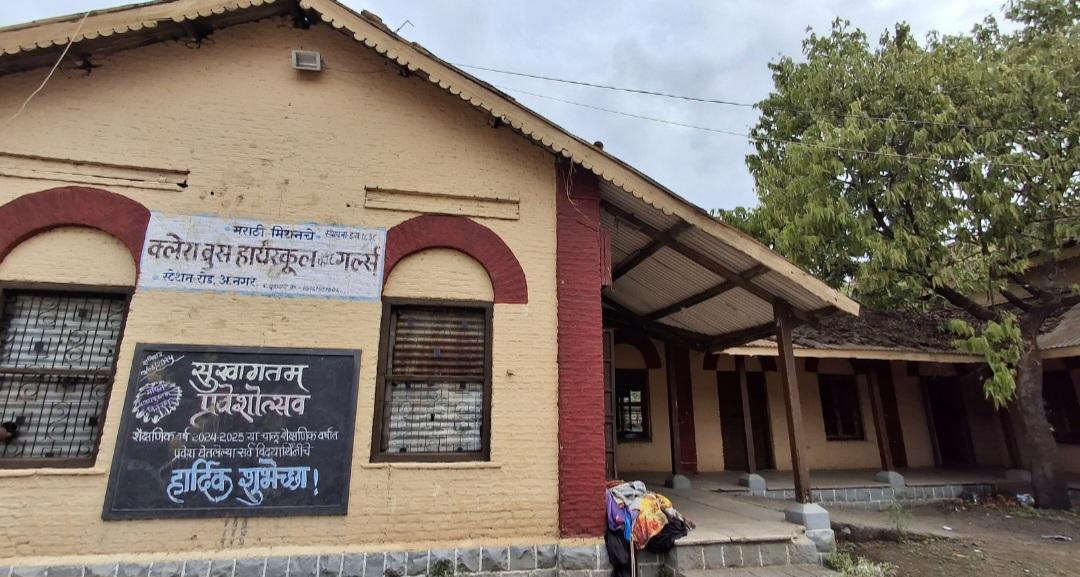
Her work significantly influenced Indian social reformers, including Mahatma Jyotiba Phule. During his visit to Clara Bruce High School in 1848, Phule was inspired to establish a girls’ school in Pune, which later became the first girls’ school in India founded and operated by an Indian. Savitribai Phule, Jyotiba Phule’s wife and a prominent social reformer, also underwent teacher training at Clara Bruce High School before embarking on her pioneering journey in education.
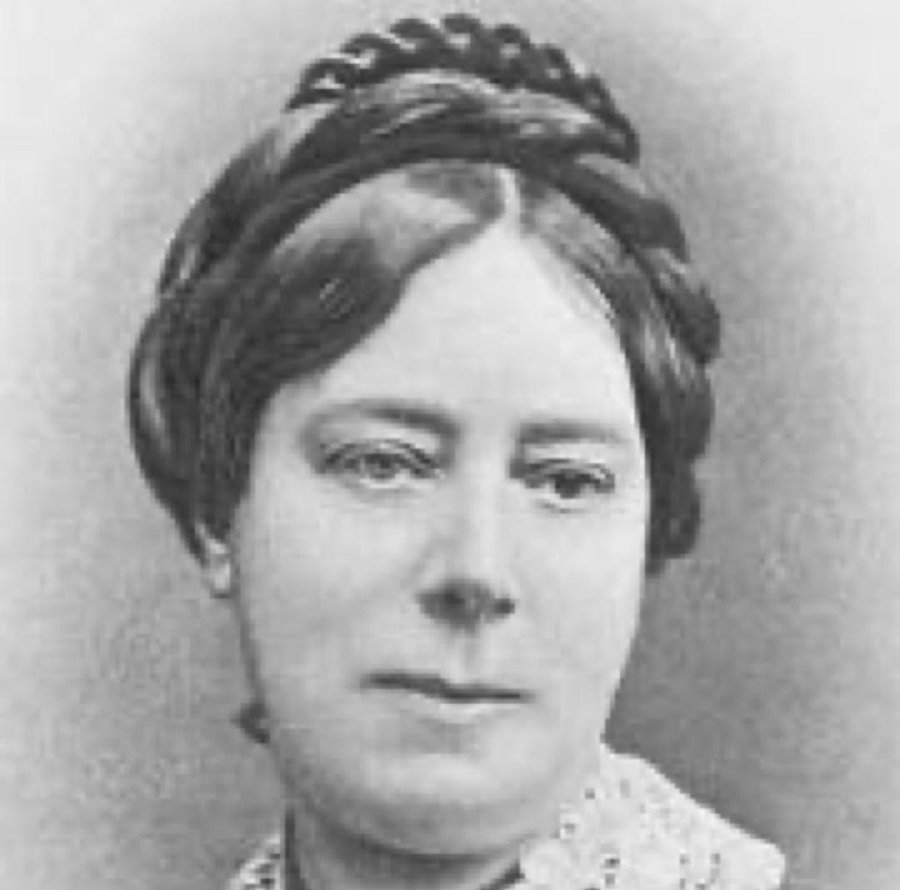
Farrar’s dedication to women’s education was part of a broader effort by the American Board of Commissioners for Foreign Missions. In 1826, this organization sought a single female missionary to direct schools for girls in “Bombay” (now Mumbai). Despite the initial reluctance of American missionary societies to send unmarried women abroad, Farrar was appointed as Superintendent of Girls’ Schools. After departing from Boston, she arrived in Mumbai and subsequently took charge of educational initiatives in Ahilyanagar from 1839. Farrar was assigned to Ahilyanagar in 1839 to establish and oversee girls' schools and continued her work until her death in 1862.
Local Figures & Organizations
As mentioned above, while entities from the West played a significant role in shaping the educational landscape of Ahilyanagar, local figures and organizations also emerged as key contributors. Many of them established institutions that continue to shape education in the district today, alongside community-led organizations that have played a lasting role in its development.
Ahmednagar Jilha Maratha Vidya Prasarak Samaj
The Ahmednagar Jilha Maratha Vidya Prasarak Samaj is an educational trust established in 1918 in Ahilyanagar. It is one of the oldest educational institutions in the region and was founded with inspiration and financial support from Chhatrapati Shahu Maharaj of Kolhapur, a significant proponent of education and social reform in Maharashtra.
Since its inception, the organization has contributed to the expansion of educational infrastructure across the district. It has established a diverse range of institutions, including higher and technical colleges, secondary schools, and ashram schools. The trust’s efforts have played a vital role in diversifying educational opportunities in Ahilyanagar, particularly benefiting marginalized communities by improving access to quality education.
Hind Seva Mandal
The Hind Seva Mandal is another key educational organization in Ahilyanagar, founded in 1922. Since its establishment, it has focused on expanding educational opportunities throughout the district. The organization has been instrumental in founding numerous schools and colleges across the district.
Post-Independence Era and Contemporary Educational Infrastructure
Following India's independence, the education system in Ahilyanagar underwent major transformations. The introduction of structured education levels—pre-primary, primary, secondary, and higher education and the implementation of National Education Policies heavily shaped the educational landscape of the district. Over the years, the education sector developed with contributions from both government-funded institutions and private organizations. Additionally, Educational boards were also introduced, each offering distinct curricula and standards, providing students with more choices.
Primary & Secondary Education
During the colonial period, both public and private efforts in education primarily focused on primary and secondary schooling, as indicated by data from district gazetteers across Maharashtra. Higher education remained underdeveloped in most districts, including Ahilyanagar, with gradual improvements taking place over time. While basic infrastructure for primary and secondary education existed, its expansion was closely tied to increasing enrollment and involvement of more local figures over the years. Today, this expansion can be seen in the ways schools are spread across various wards of Ahilyanagar city and the data available on the number of schools listed.
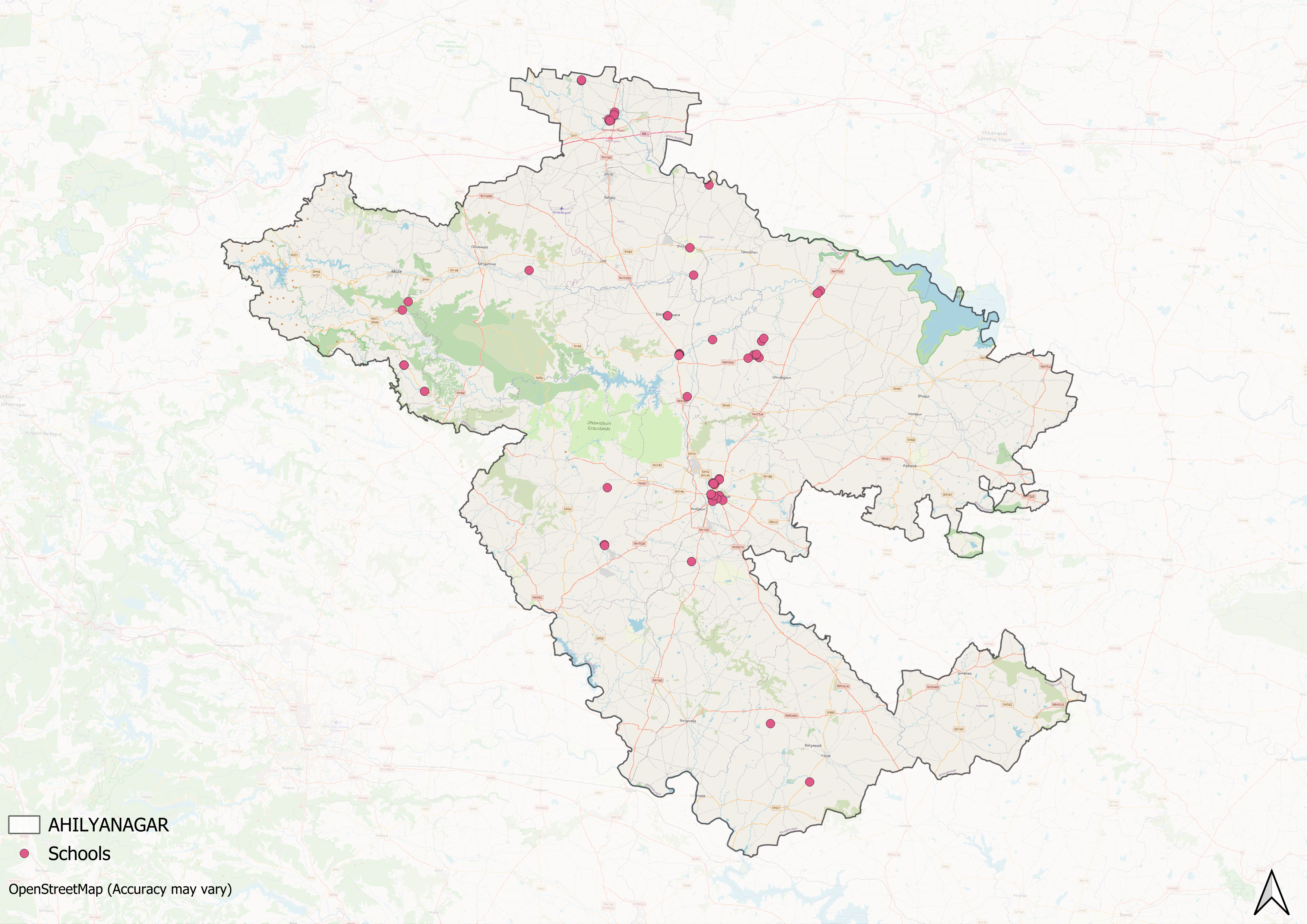
Over time, institutions affiliated with various educational boards also emerged. Locals identify the State Secondary Certificate (SSC) Board and the Central Board of Secondary Education (CBSE) as the two boards currently available in the district. Notably, the availability of CBSE board schools is a rather recent phenomenon. Locals say that in the last two decades, CBSE schools have gained popularity, leading to the establishment of institutions such as Takshila School, Army Public School, St. Michael’s School, Icon Public School, and Vikhe Patil School.
Alongside this, over the years, language preferences and medium of instruction has also changed over the years, Historically, Marathi was the dominant medium of instruction in most schools, as noted in the 1976 district Gazetteer.
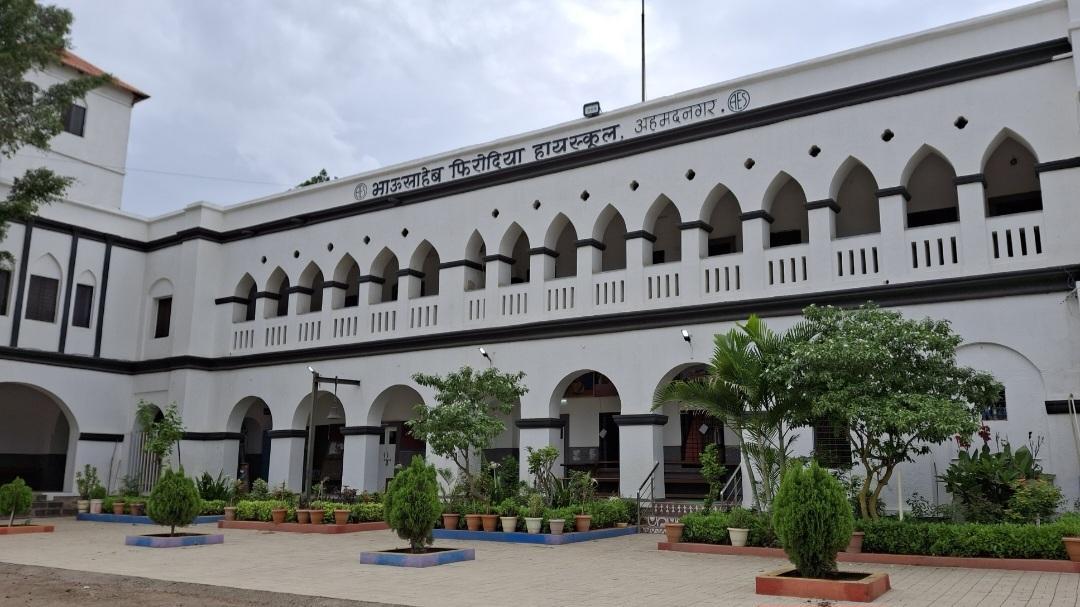
However, locals report that over the past two to three decades, the preference for Marathi as the primary language of instruction has declined. This shift has occurred alongside broader changes in education across the country. With a growing demand for English-medium education, particularly in urban areas, numerous private English-medium schools have been established. This trend is most noticeable in cities, where English-medium institutions have become the preferred choice for many families. However, Marathi-medium schools remain prevalent in rural parts of the district, continuing to serve local communities.
Institutions of Higher Learning
Perhaps one of the most notable changes in Ahilyanagar’s educational landscape is tied to the establishment of higher education institutions. While primary and secondary schooling expanded steadily, opportunities for advanced education remained limited for much of the district’s history. Over time, local leaders and organizations played a crucial role in addressing this gap, leading to the creation of several colleges. As a result, many institutions in the district today are privately managed, semi-private, or autonomous.
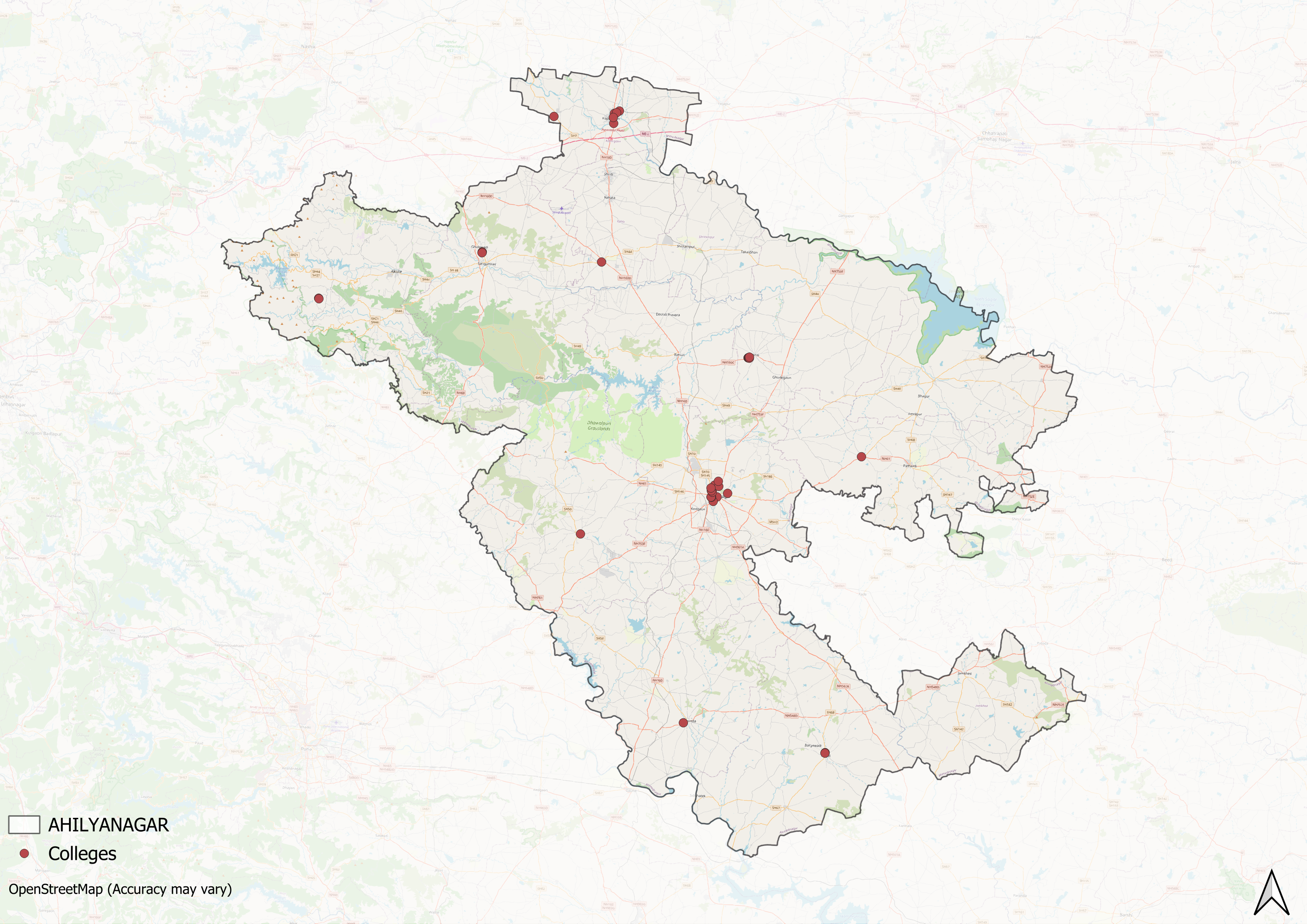
Alongside these institutions, many more spaces for higher learning operate across the district, offering programmes in a range of fields. However, while one can see here that higher education opportunities have expanded since the post-independence days, geographic disparities appear to persist, with urban centers having better access to institutions compared to rural areas.
Ahmednagar College
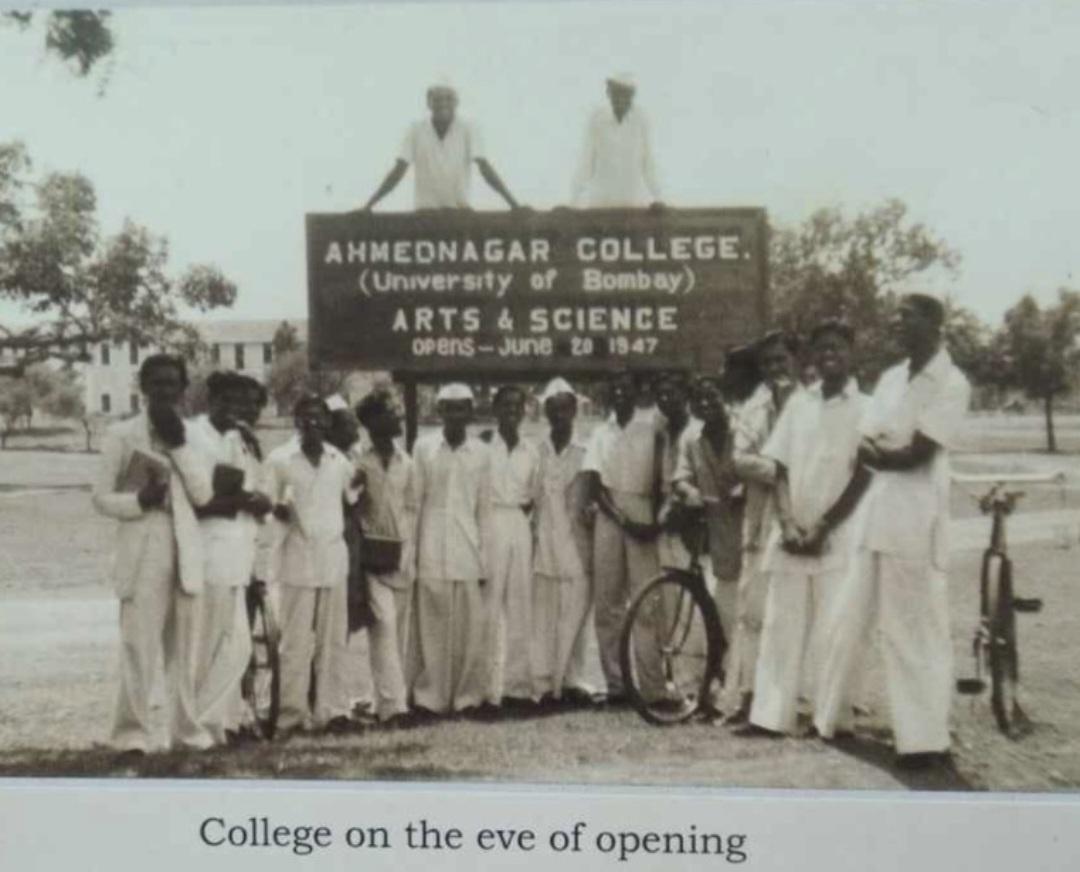
Ahmednagar College, located in the Chandni Chowk area of Ahilyanagar district, was established in 1947. It is recognized as the first and oldest institution of higher education in the district.
The college was founded by Rev. Dr. B.P. Hivale with support from the American Marathi Mission and various other benefactors. Since its establishment, it has served as a major center for higher education in the region. The institution is affiliated with the University of Pune and is now part of the Bhaskar Pandurang Hivale Education Society, which also oversees the Institute of Social Work & Research and the Institute of Management Studies, Career Development & Research.
Hind Seva Mandal’s Pemraj Sarda College
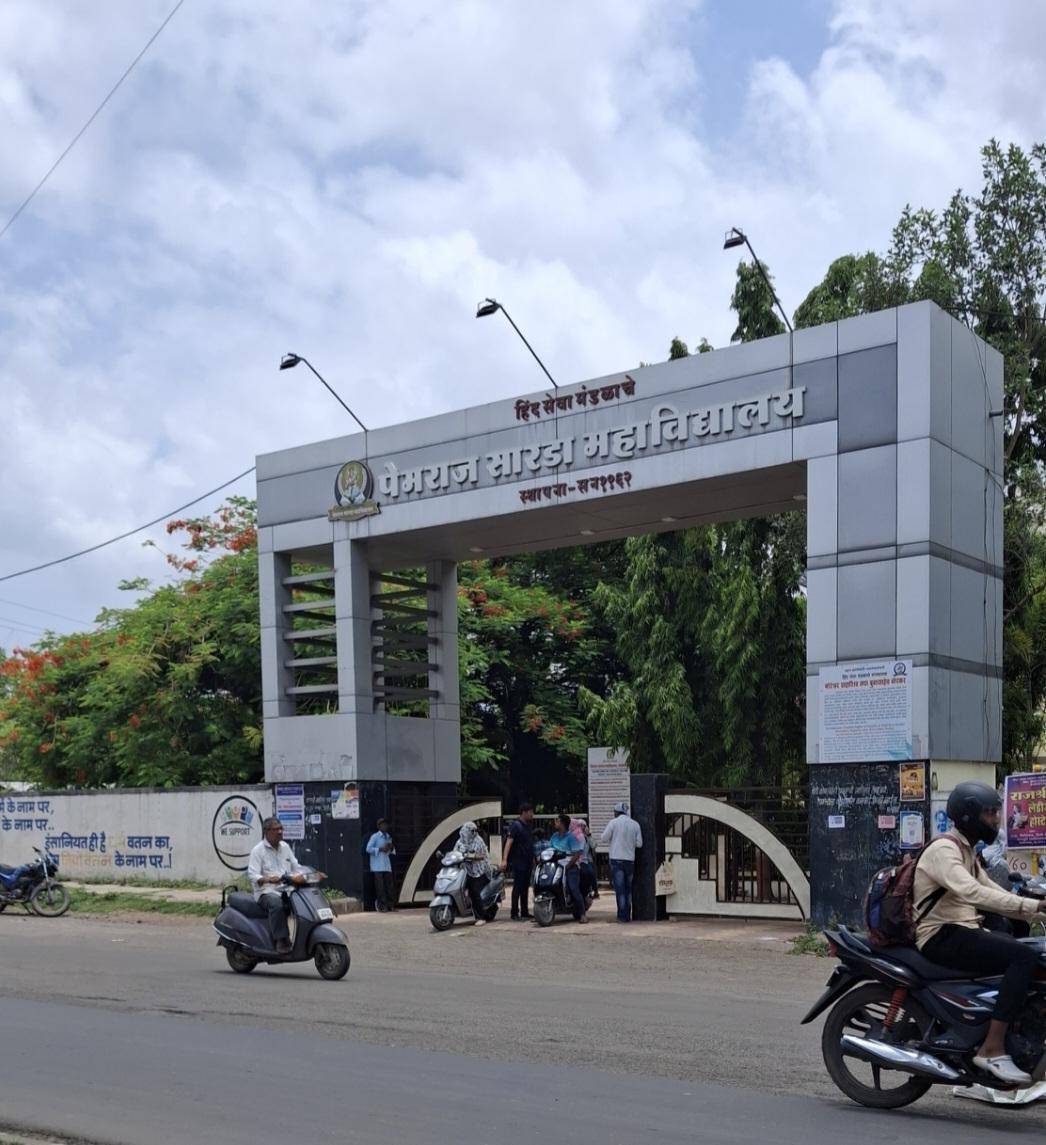
Pemraj Sarda College, established in 1962 by Hind Seva Mandal, is a prominent institution for higher secondary and higher education in Ahilyanagar. Located in Savedi, the college is particularly known for its emphasis on science and commerce education. While it is highly regarded for its 11th and 12th standard programs, it also offers a range of undergraduate and postgraduate courses.
AJMVPS New Arts Commerce and Science College
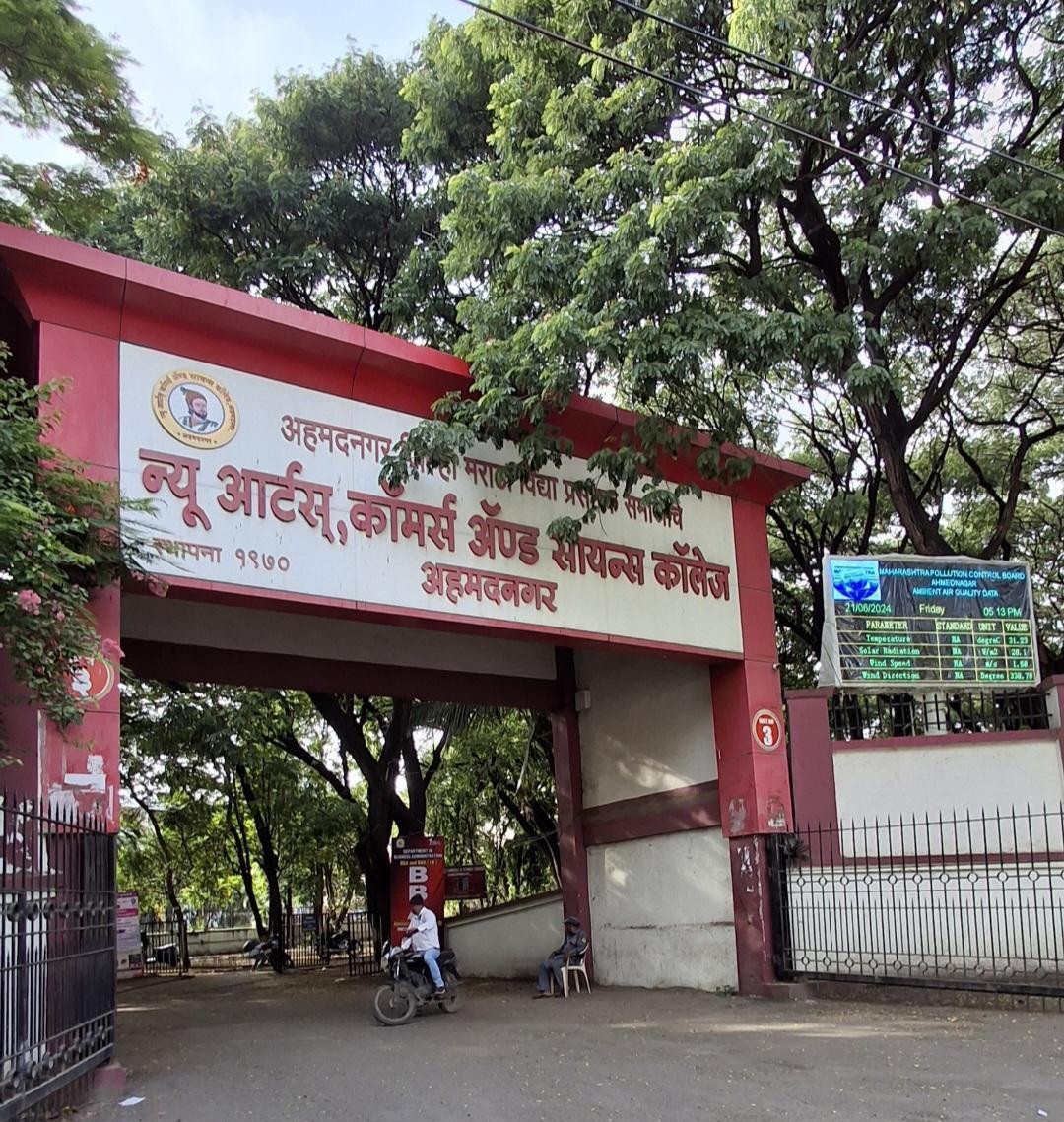
Founded in 1970 by Ahmednagar Jilha Maratha Vidya Prasarak Samaj (AJMVPS), New Arts, Commerce & Science College is an autonomous institution located in Tarakpur. The college offers a wide range of undergraduate and postgraduate programs across various disciplines.
Mahatma Phule Krishi Vidyapeeth Rahuri
Mahatma Phule Krishi Vidyapeeth (MPKV) is an agricultural university located in Rahuri. It is regarded as the first agricultural university in Maharashtra. Established as Maharashtra Agricultural University, it was later renamed in honor of Jyotirao Phule, a pioneering social reformer known for his contributions to education and agriculture.
MPKV is one of the leading institutions in agricultural education and research in India. The university traces its roots to the College of Agriculture, Pune, which was founded in 1907 and is among the oldest agricultural colleges in Asia. Today, MPKV serves a vast jurisdiction covering ten districts of Western Maharashtra, aside from Ahilyanagar, including Kolhapur, Sangli, Satara, Solapur, Pune, Nashik, Dhule, Nandurbar, and Jalgaon.
The university operates across four of Maharashtra’s nine agro-climatic zones, the Western Ghat Zone, Sub-Montane Zone, Western Maharashtra Plain Zone, and Scarcity Zone, allowing it to focus on region-specific agricultural research and development.
Pravara Institute of Medical Sciences
One of the key private institutions in Ahilyanagar is the Pravara Institute of Medical Sciences (PIMS), which is located in Loni. PIMS is deemed to be a university established under the University Grants Commission (UGC) Act of 1956, and its status as a university allows it to offer a wide range of academic programs in the medical field.
The university includes seven constituent colleges that provide specialized education in fields such as rural healthcare (through Dr. Balasaheb Vikhe Patil Rural Medical College), dentistry (Rural Dental College), public health (School of Public Health and Social Medicine), and biotechnology (Center for Biotechnology). Students are given practical training at both Primary Health Centers and tertiary healthcare institutions, ensuring a broad exposure to different levels of healthcare delivery. The university offers undergraduate programs, postgraduate courses, and research opportunities, allowing students to specialize in various areas of medicine.
Vithalrao Vikhe Patil Foundation’s Medical College
The Vithalrao Vikhe Patil Foundation Medical College is a private medical school located in Vilad Ghat. Founded by the Vithalrao Vikhe Patil Foundation, the college offers Bachelor of Medicine, Bachelor of Surgery (MBBS) program and postgraduate programs in 10 medical specialties. The college is affiliated with the Maharashtra University of Health Sciences.
The college is affiliated with the Dr. Vikhe Patil Memorial Hospital, a 990-bed facility, which serves as a teaching hospital for students. In addition, the college operates an Urban Health Training Centre in Ahilyanagar and a Rural Health Training Center in Vambori, both of which provide training for undergraduate students in diverse healthcare settings.
Shadow Education
In recent years, shadow education, referring to private coaching and supplementary learning outside formal schooling, has increasingly become an integral part of India’s education system. Coaching institutions have gained prominence, particularly for students preparing for competitive entrance exams.
In Ahilyanagar, the past five to six years have seen a rise in coaching centers, with several institutes establishing themselves in the city. These centers offer specialized instruction for exams such as CET, NEET, and JEE, providing additional support alongside regular schooling. In response to the growing demand for structured coaching in the district, new initiatives have been introduced to formalize and expand these services.
Pravara Pattern
The Pravara Pattern is one such structured coaching model which was introduced in 2022 at the Pravara Rural Education Institute in Loni town of Ahilyanagar district. It was developed as an initiative by MLA Radhakrishna Vikhe Patil, it is designed to provide systematic and specialized coaching for students preparing for competitive entrance exams in professional fields such as Engineering, Medicine, Pharmacy, Agriculture, Architecture, and the National Defence Academy .
The Pravara Pattern focuses on multiple-choice question (MCQ) practice, structured lecture plans, and supervised self-study sessions. It incorporates biweekly chapter-wise tests, modeled on CET, NEET, and JEE formats, to help students track their progress. Individual counseling and career guidance seminars are also included to provide academic and professional support.
To aid students in exam preparation, the institute maintains a dedicated library with reference materials for entrance exams and offers online mock tests to familiarize students with exam formats and time constraints. The Pravara Pattern aims to enhance the learning experience by offering structured guidance, regular assessments, and academic support, preparing students for higher education and professional careers.
Prominent Figures & Organizations
Dr. Vithalrao Vikhe Patil
Dr. Vithalrao Eknathrao Vikhe Patil was an Indian industrialist and social reformer, best known for establishing India’s first cooperative sugar factory in Loni. A key figure in the state’s social and political landscape, he believed in rural development through education and worked to create a network of institutions that would empower communities through learning.

For his contributions to industry, rural upliftment, and education, he was honored with the Padma Shri by the Government of India in 1961.
Balasaheb Vikhe Patil
His son, Padmabhushan Balasaheb Vikhe Patil, carried forward his vision, emerging as an influential public figure who served as a Member of Parliament and Union Minister. Committed to expanding education in rural areas, he established institutions such as the Pravara Medical Trust, Pravara Rural Education Society, and the Dr. Vithalrao Vikhe Patil Foundation.

These organizations have played a crucial role in enhancing literacy rates and educational access, particularly in rural Maharashtra. By offering programs in technical, allopathic, ayurvedic, and paramedical education, they have helped bridge the gap between rural and urban communities, fostering socio-economic development in the region.
NGOs and Community-Based Education Efforts
Education has been a key driver of social reform, particularly in addressing inequality and expanding access to learning. While formal institutions provide structured education, many communities continue to face barriers due to poverty, social stigma, or lack of resources. To address these challenges, various organizations in Ahilyanagar have focused on community-based education initiatives, with each working to tackle specific social challenges present in the district.
Ujas Foundation
Ujas Foundation is an initiative under the Aditya Birla Education Trust, aimed at promoting menstrual health education in Maharashtra, including Ahilyanagar. The foundation works to address widespread misinformation and stigma surrounding menstruation, which remains a sensitive topic in many Indian households. Studies indicate that nearly half of Indian girls are unaware of menstruation until they experience their first period, leading to confusion and limited access to proper hygiene management.
To address this issue, the Ujas Foundation collaborates with 75 schools, conducting structured sessions for students in grades eight to ten. These sessions provide scientifically accurate information on menstrual health, challenge misconceptions, and aim to normalize discussions on the subject. The initiative also emphasizes the importance of educating both girls and boys, fostering a more informed and inclusive approach to menstrual health awareness.
Snehalaya
Snehalaya is a nonprofit organization established in 1989 to provide education, healthcare, rehabilitation, and advocacy for children and families from marginalized communities, particularly those affected by poverty, human trafficking, and domestic abuse.
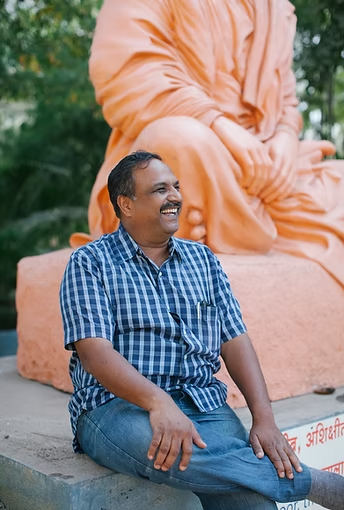
The organization traces its origins to the 1980s, when Girish Kulkarni, at the age of 19, began offering informal education to 80 children from Ahilyanagar’s Chitra Galli red-light district. Recognizing the barriers faced by these children, he initiated efforts to provide them with structured education, food, and support. These early interventions led to the establishment of Snehalaya as a formal institution dedicated to improving educational access for vulnerable groups.
With its name meaning “Home of Love,” Snehalaya operates through its Balbhavan centers and outreach programs, aiming to break cycles of exploitation and provide long-term educational and social support.
Graphs
Enrollment and Dropout Rate
Schools
Teachers
Sources
Ahmednagar Jilha Maratha Vidya Prasarak Samaj. n.d.AJMVPShttps://ajmvps.in/
Anandibai Raorane Medical College & Research Institute. n.d. Institution Website.https://ajmvps.in/.
Anandibai Raorane Medical College & Research Institute. n.d.About Us.Anandibai Raorane Medical College & Research Institute.
BPHE Society’s Ahmednagar College. n.d. “History of ACA.”http://www.aca.edu.in/About/History.aspx.
Divya Marathi. 2022. “Pravara Pattern of Competitive Examinations.” Divya Marathi.https://divyamarathi.bhaskar.com/amp/local/m…
Dr. Vithalrao Vikhe Patil Foundation’s Medical College & Hospital. n.d. Institution Website.https://www.vimsmch.edu.in/Foundation.
Femina.2022. “Advaitesha Birla on Ujaas: Her Initiative on Menstrual Health.”Femina.https://www.femina.in/trending/achievers/adv…
Gazetteer of Bombay City and Island. 1909.The Gazetteer of Bombay City and Island, Vol. 1.Gazetteers Department, Government of Maharashtra, Mumbai.
Gazetteers of the Bombay Presidency. 1884 (Reprinted 2003, e-Book Edition 2006). Gazetteers of the Bombay Presidency: Ahmadnagar District, Volume XVII. Gazetteers Department, Government of Maharashtra, Mumbai.
Government of Maharashtra. n.d.Education in Ahmadnagar District.Gazetteers Department, Government of Maharashtra, Mumbai.
Hind Seva Mandal. n.d.Institution Website.https://hindsevamandal.org/
Indian Council of Agricultural Research (ICAR). n.d. “University Details.https://education.icar.gov.in/Univ_Details_N…
James, Edward T., Janet Wilson James, and Paul S. Boyer. 1971. Notable American Women, 1607–1950: A Biographical Dictionary, Vol. 2. Harvard University Press, Cambridge, MA.
Kamdar, Shraddha. 2022. “Advaitesha Birla on Ujaas – Her Initiative on Menstrual Health.Femina.https://www.femina.in/trending/achiev…
Maharashtra State Gazetteers. 1976. Ahmadnagar District Gazetteer. Gazetteers Department, Government of Maharashtra, Mumbai.
Mathew, Anju Ann. 2021. “Meet Girish Kulkarni, Who Is Empowering Sex Workers and Educating Their Children.” YourStory.https://yourstory.com/socialstory/2021/04/gi…
Pravara Institute of Medical Sciences Deemed to be University. n.d. Institution Website.https://pravara.in/pravara-science-academy-l…
Pravara Rural Education Society. n.d. Institution Website.https://www.pravara.com/university.html.
Pravara Science Academy, Loni. n.d. Institution Website.https://pravara.in/pravara-science-academy-l…
Pravara Science Academy. n.d.About Us.Pravara Science Academy.
The Satyashodhak. 2025. “Cynthia Farrar: Missionary Woman Who Inspired Jotirao Phule.” The Satyashodhak.https://thesatyashodhak.com/cynthia-farrar-m…
Last updated on 28 July 2025. Help us improve the information on this page by clicking on suggest edits or writing to us.